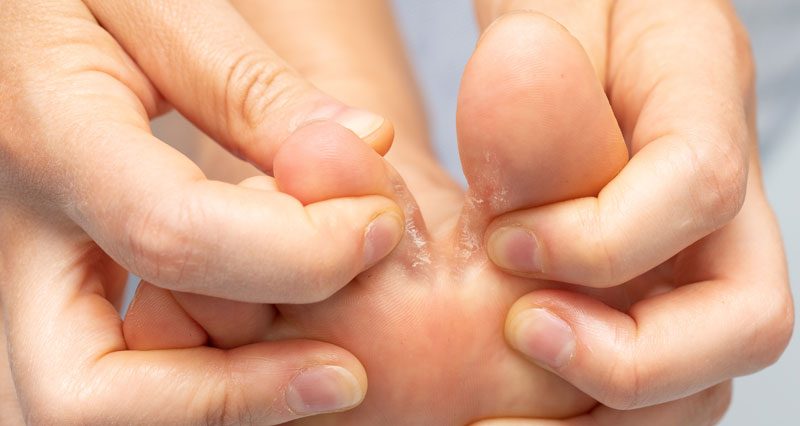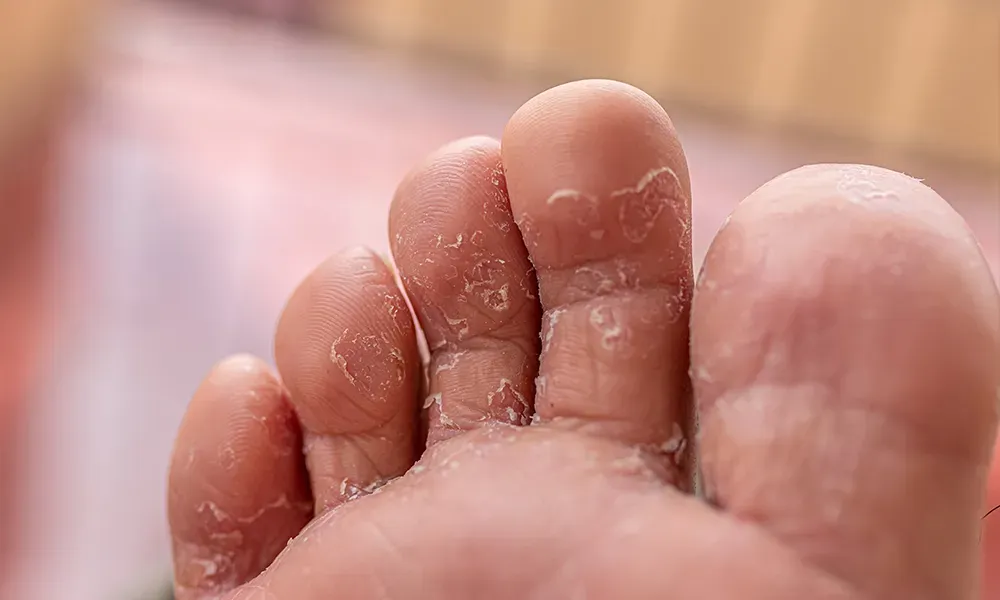Athlete’s foot is a common fungal skin infection that typically starts between the toes. It often affects individuals whose feet are sweaty and confined within tight-fitting shoes.
Athlete’s foot, also known as tinea pedis or ringworm of the foot, is caused by the fungus Trichophyton, which is commonly found on floors and in clothing.
This fungus only infects the skin under specific conditions, requiring a warm and moist environment, such as the inside of a shoe. As a result, only about 0.75 percent of people who regularly walk barefoot are affected. However, up to 70 percent of people will develop athlete’s foot at some point.
Athlete’s foot most commonly develops between the toes, causing burning, stinging, redness, itching, and flaking of the skin in some individuals. It is the most common type of fungal infection. Although contagious, athlete’s foot can usually be treated with over-the-counter (OTC) medications.
Causes
Athlete’s foot is caused by the fungus Trichophyton, a type of dermatophyte related to other fungi that cause infections in human skin, hair, and nails. These fungi exist harmlessly on the skin under normal conditions. However, they multiply rapidly in damp and warm environments.
Thick, tight shoes, especially those made of plastic, are more likely to trigger athlete’s foot because they create ideal conditions for the fungus to thrive by squeezing the toes together, keeping the area warm and moist. Leather or canvas shoes are less likely to cause this problem. Wearing damp socks and having warm feet also increase the risk.
Athlete’s foot spreads through direct and indirect contact:
- Direct contact: This occurs through skin-to-skin contact, such as when an uninfected person touches the infected area of someone with athlete’s foot.
- Indirect contact: This happens via contaminated surfaces, clothing, socks, shoes, bed sheets, and towels.
Communal areas like swimming pools and showers are common places for the spread of athlete’s foot due to their humid and warm conditions.
Additionally, individuals with weakened immune systems are more susceptible to developing athlete’s foot.

Signs and Symptoms
Athlete’s foot can affect one or both feet and presents with the following symptoms:
- Scaly, peeling, or cracked skin between the toes
- Itchiness, especially after removing shoes and socks
- Inflamed skin that may appear reddish, purplish, or grayish depending on skin color
- Burning or stinging sensation
- Blisters
- Dry, scaly skin on the bottom of the foot that extends up the side
Sometimes, the skin affected by athlete’s foot can crack and may exhibit oozing or crusting, itchy blisters, and swelling. The sole and side of the foot may develop scaling patterns. In severe cases, bacterial infections can occur alongside the fungal infection. Open sores caused by athlete’s foot make the skin more vulnerable to bacterial invasion.
If left untreated, the infection can spread from one toe to another. A rash may develop on the sides and bottom of the feet. In rare instances, athlete’s foot can spread to the hands, a condition known as tinea manuum, which presents symptoms similar to those experienced on the feet. People who do not wash their hands immediately after touching the affected area on their foot are at higher risk of developing tinea manuum.
Scratching the affected area and then touching other parts of the body can also spread the infection. Therefore, it is crucial to treat athlete’s foot as soon as symptoms appear. After touching the affected area, washing hands thoroughly with soap and warm water is essential to prevent spreading the infection.

Diagnosis of Athlete’s Foot
Clinical Examination
- Visual Inspection:
- A healthcare provider will examine the affected area, looking for typical signs such as redness, scaling, and flaking.
- They will check for any cracks, oozing, blisters, or swelling.
- Patient History:
- The provider will ask about symptoms, their duration, and any factors that might have triggered or worsened them, such as wearing tight or damp shoes.
- They will inquire about any recent use of communal showers, swimming pools, or other places where the infection might have been contracted.
- Previous occurrences of similar symptoms and treatments used.
Laboratory Tests
- KOH Test (Potassium Hydroxide Preparation):
- A skin scraping is taken from the affected area and placed on a slide with potassium hydroxide (KOH).
- Under a microscope, KOH dissolves the skin cells but leaves the fungal cells intact, allowing for easy identification of fungal elements.
- Fungal Culture:
- A sample of skin scraping or blister fluid is sent to a lab where it is cultured to see if fungus grows.
- This test can identify the specific type of fungus causing the infection but takes longer than the KOH test.
Treatments for Athlete’s Foot
Over-the-Counter (OTC) Medications

- Topical Antifungals:
- Commonly recommended creams containing miconazole.
- Other effective antifungal medications include:
- Clotrimazole
- Econazole
- Ketoconazole
- Miconazole
- Terbinafine
- Sulconazole
- Forms of Topical Medications:
- Available in various forms such as creams, powders, liquids, and sprays.
- These medications are applied directly to the affected skin to kill the fungus causing the infection.
Prescription Medications
- Oral Antifungals:
- Prescribed for severe cases or when topical treatments fail.
- Examples include:
- Griseofulvin
- Itraconazole
- Terbinafine
- Considerations for Oral Antifungals:
- Antacids can interfere with absorption.
- They may affect the efficacy of anticoagulant drugs.
- Elderly patients, young children, pregnant individuals, or those planning to have children should consult a doctor due to potential side effects and interactions.
Additional Treatments

- Hydrocortisone:
- Recommended for very sore and swollen skin.
- Available in low-dose OTC forms or higher doses with a prescription.
Home Remedies
- Foot Hygiene:
- Wash feet often with soap and water.
- Ensure feet are completely dry after washing, especially between the toes.
- Foot Soaks:
- Soak feet in salt water or diluted vinegar to clear up blisters.
- Soaking feet in a tea tree oil solution can help; tea tree oil is available for purchase online.
- Footwear and Clothing:
- Wear clean cotton socks.
- Change shoes and socks often to keep feet dry.
- Walk barefoot at home as much as possible.
- Towels and Shared Items:
- Wash towels regularly and do not share them to prevent spreading the infection.
Prevention of Athlete’s Foot
- Foot Hygiene:
- Wash feet twice a day with soap and water, ensuring to clean between the toes.
- Keep feet dry; use antifungal talcum powder if needed.
- Remove shoes immediately after exercise or sports.
- Footwear:
- Wear loose-fitting, well-ventilated shoes made of leather or canvas.
- Ensure feet are dry before putting on socks, stockings, or tights.
- Use moisture-wicking socks made of cotton, silk, or wool.
- Change shoes regularly to allow them to dry out.
- Public Areas:
- Wear pool slippers when walking around public swimming pools, communal changing rooms, and shower areas.
- General Practices:
- Do not share footwear.
- Wash sheets and towels regularly.
- Check pets for signs of hair loss and seek veterinary care if needed, as pets can transmit the fungus to humans.
- School and Children:
- Children with athlete’s foot can attend school, but teachers should be informed to take appropriate measures during physical education classes.
- Ensure the child does not walk barefoot at school.
When to See a Doctor
- If symptoms do not improve within two weeks of OTC treatment.
- If there are signs of a bacterial infection, such as swelling, pus, or fever.
- If you have diabetes and suspect athlete’s foot.
Maintaining good foot hygiene and taking preventative measures can help minimize the risk of developing athlete’s foot.
